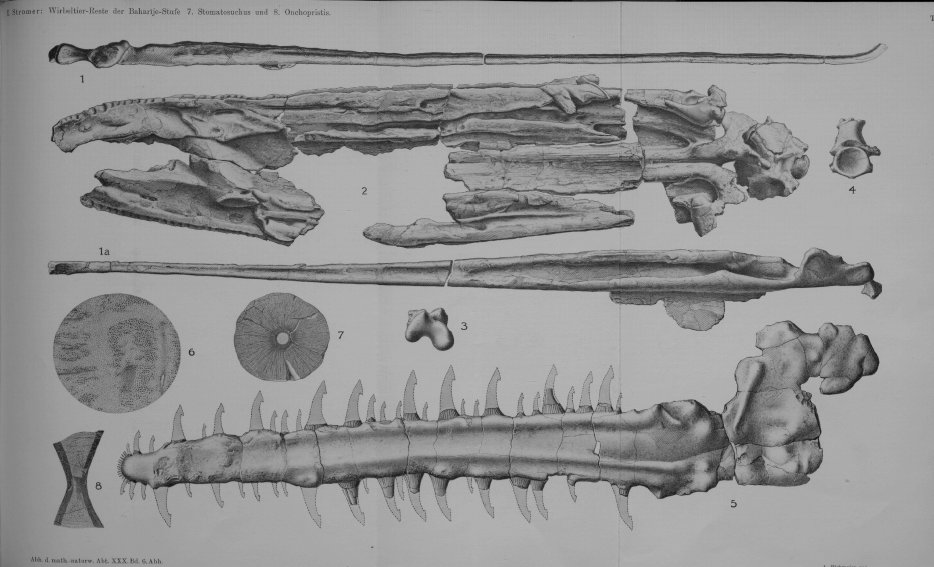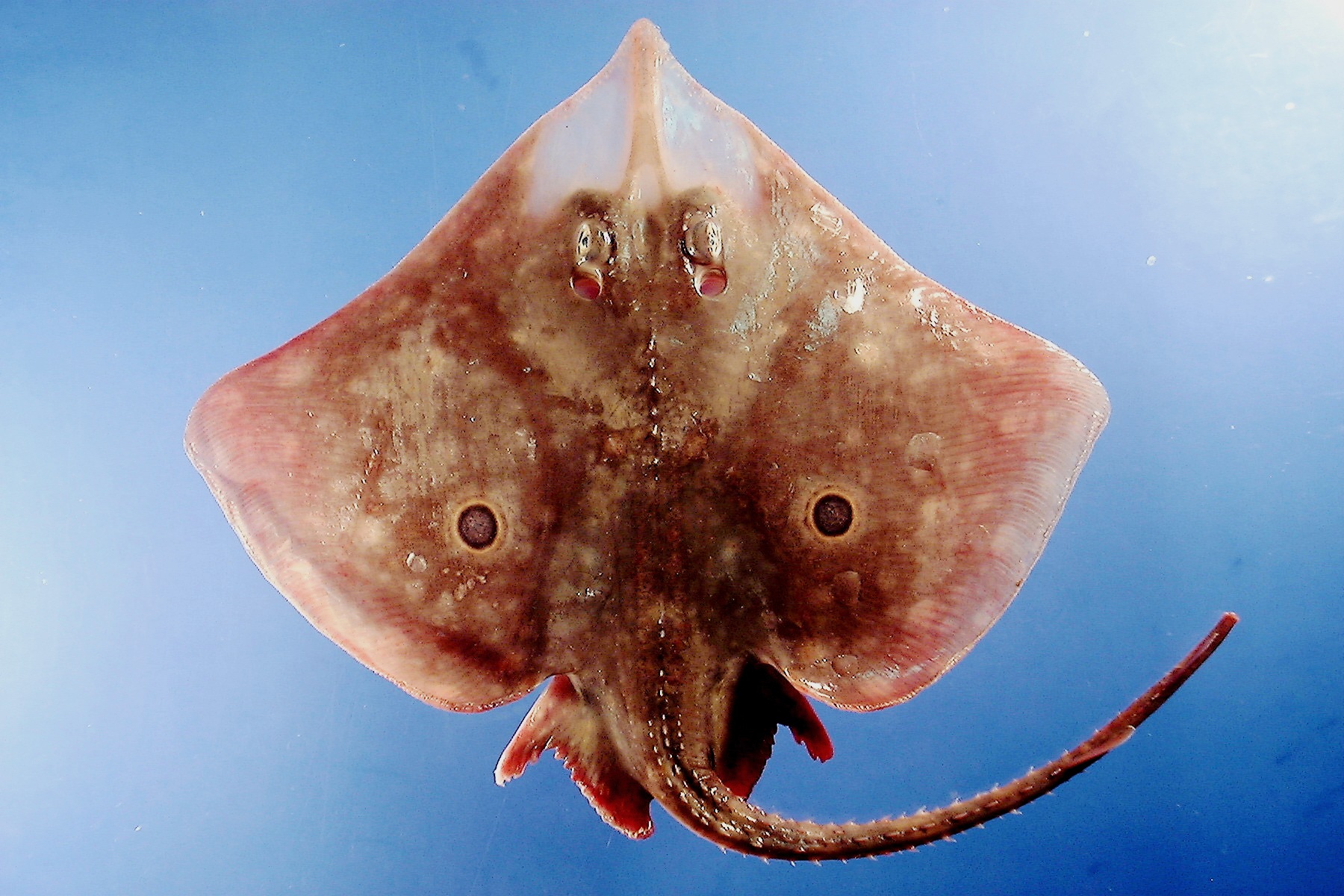|
Sclerorhynchoidei
Sclerorhynchoidei is an extinct suborder of Rajiformes, rajiform Batoidea, rays that had long Rostrum (anatomy)#Vertebrates, rostra with large Fish scale#Placoid scales, denticles similar to Sawfish, sawfishes and Sawshark, sawsharks. This feature was convergent evolution, convergently evolved, recently proposed as 'pristification', and their closest living relatives are actually Skate (fish), skates. While they are often called "sawfishes", sawskates is a more accurate common name proposed in 2021 for sclerorhynchoids, which has been subsequently used by other researchers. The suborder contains five named families: Ganopristidae, Ischyrhiza, Ischyrhizidae, Onchopristis, Onchopristidae, Ptychotrygonidae, and Schizorhizidae. Several genera (see below) are not currently placed in any of these families. Sclerorhynchoids first appeared in the Barremian and went extinct during the Cretaceous–Paleogene extinction event, with former Paleocene occurrences being misidentifications or Fo ... [...More Info...] [...Related Items...] OR: [Wikipedia] [Google] [Baidu] |
Sawfish
Sawfish, also known as carpenter sharks, are a family of very large rays characterized by a long, narrow, flattened rostrum, or nose extension, lined with sharp transverse teeth, arranged in a way that resembles a saw. They are among the largest fish, with some species reaching lengths of about . They are found worldwide in tropical and subtropical regions in coastal marine and brackish estuarine waters, as well as freshwater rivers and lakes. All species are critically endangered. They should not be confused with sawsharks (order Pristiophoriformes) or the extinct sclerorhynchoids (order Rajiformes) which have a similar appearance, or swordfish (family Xiphiidae) which have a similar name but a very different appearance. Sawfishes are relatively slow breeders and the females give birth to live young. They feed on fish and invertebrates that are detected and captured with the use of their saw. They are generally harmless to humans, but can inflict serious injuries with th ... [...More Info...] [...Related Items...] OR: [Wikipedia] [Google] [Baidu] |
Onchopristis
''Onchopristis'' is an extinct genus of Sclerorhynchoidei, sclerorhynchoid, or sawskate, from the Cretaceous of North Africa, Europe, North America, and potentially South America. It contains two valid species, ''O. numida'' and ''O. dunklei'', though some researchers argue that both may be considered a single taxon with variation in morphology caused by a wide geographical range. Specimens of ''Onchopristis'' have been discovered in coastal and fluvial deposits dated from the Barremian to the Cenomanian ages (~125-94 Million year, mya), making this genus one of the oldest known sclerorhynchoids. Discovery and naming In 1905, the French paleontologist Émile Haug named ''Onchosaurus, Gigantichthys numidus'' based fragmentary rostral denticles from the Continental intercalaire of Algeria, and named ''Platyspondylus foureaui'' based on vertebrae from the same formation. Articulated specimens have confirmed that the rostral denticles and vertebrae belong to the same species. In 1917, ... [...More Info...] [...Related Items...] OR: [Wikipedia] [Google] [Baidu] |
Rajiformes
Rajiformes is one of the four Order (biology), orders in the clade Batomorphi, often referred to as the superorder Batoidea, flattened cartilaginous fishes related to sharks. Rajiforms are distinguished by the presence of greatly enlarged pectoral fins, which reach as far forward as the sides of the head, with a generally flattened body. The undulatory pectoral fin motion diagnostic to this taxon is known as Batoid locomotion, rajiform locomotion. The eyes and Spiracle (vertebrates), spiracles are located on the upper surface of the head and the gill slits are on the underside of the body. Most species give birth to live young, although some lay eggs enclosed in a horny capsule ("mermaid's purse"). Characteristics Rajoids typically have a dorsoventrally flattened body. The snout is slender and pointed and the wide mouth, often covered with a fleshy nasal flap, is on the underside of the head. The eyes and well-developed spiracles are located on the top of the head. In most spec ... [...More Info...] [...Related Items...] OR: [Wikipedia] [Google] [Baidu] |
Ischyrhiza
''Ischyrhiza'' is an extinct genus of sclerorhynchoid ray from the Late Cretaceous (Cenomanian-Maastrichtian). It had a large, toothed rostrum closely resembling that of a modern-day sawfish. Despite formerly being classified within a family of extinct sawfish-like rays known as Sclerorhynchidae, phylogenetic analyses indicate that ''Ischyrhiza, Schizorhiza'', and ''Onchopristis'' form a distinct clade that groups closer with the extant family Rajidae, which contains the true skates, possibly rendering the suborder Sclerorhynchoidei paraphyletic. Fossils of the genus have been found in Canada, the United States, the Aguja Formation of Mexico, the Bissekty Formation of Uzbekistan, the Tamayama Formation of Japan, the Dukamaje Formation The Dukamaje Formation is a geological formation in Niger and Nigeria whose strata date back to the Late Cretaceous The Late Cretaceous (100.5–66 Ma) is the more recent of two epochs into which the Cretaceous Period is divided i ... [...More Info...] [...Related Items...] OR: [Wikipedia] [Google] [Baidu] |
Onchopristidae
''Onchopristis'' is an extinct genus of sclerorhynchoid, or sawskate, from the Cretaceous of North Africa, Europe, North America, and potentially South America. It contains two valid species, ''O. numida'' and ''O. dunklei'', though some researchers argue that both may be considered a single taxon with variation in morphology caused by a wide geographical range. Specimens of ''Onchopristis'' have been discovered in coastal and fluvial deposits dated from the Barremian to the Cenomanian ages (~125-94 mya), making this genus one of the oldest known sclerorhynchoids. Discovery and naming In 1905, the French paleontologist Émile Haug named '' Gigantichthys numidus'' based fragmentary rostral denticles from the Continental intercalaire of Algeria, and named ''Platyspondylus foureaui'' based on vertebrae from the same formation. Articulated specimens have confirmed that the rostral denticles and vertebrae belong to the same species. In 1917, Ernst Stromer assigned "''G''". ''numidus ... [...More Info...] [...Related Items...] OR: [Wikipedia] [Google] [Baidu] |
Schizorhizidae
Schizorhizidae is an extinct family of cartilaginous fish from the Late Cretaceous belonging to the suborder Sclerorhynchoidei. This family contains the genera '' Harranahynchus'' and ''Schizorhiza''. It was originally named as a subfamily of Sclerorhynchidae, but was later raised to the rank of family. References Sclerorhynchoidei † A dagger, obelisk, or obelus is a typographical mark that usually indicates a footnote if an asterisk has already been used. The symbol is also used to indicate death (of people) or extinction (of species or languages). It is one of the mo ... Prehistoric cartilaginous fish families {{paleo-rajiformes-stub ... [...More Info...] [...Related Items...] OR: [Wikipedia] [Google] [Baidu] |
Ptychotrygon
''Ptychotrygon'' is a genus of sawfish-like ray whose fossils have been found worldwide from the Cretaceous period (Albian-Maastrichtian). Along with '' Ptychotrygonoides'', '' Texatrygon'', and ''Asflapristis'', it is the member of the family Ptychotrygonidae within the suborder Sclerorhynchoidei Sclerorhynchoidei is an extinct suborder of Rajiformes, rajiform Batoidea, rays that had long Rostrum (anatomy)#Vertebrates, rostra with large Fish scale#Placoid scales, denticles similar to Sawfish, sawfishes and Sawshark, sawsharks. This featu .... Species The following species are considered valid: * †''Ptychotrygon ameghinorum'' * †''Ptychotrygon blainensis'' * †''Ptychotrygon eutawensis'' * †''Ptychotrygon geyeri'' * †''Ptychotrygon mcnultyi'' * †''Ptychotrygon nazeensis'' * †''Ptychotrygon pustulata'' * †''Ptychotrygon rostrispatula'' * †''Ptychotrygon striata'' * †''Ptychotrygon triangularis'' * †''Ptychotrygon vermiculata'' References Prehisto ... [...More Info...] [...Related Items...] OR: [Wikipedia] [Google] [Baidu] |
Asflapristis
''Asflapristis'' is an extinct genus of ptychotrygonid sclerorhynchoid that lived during the Late Cretaceous. It contains two valid species: ''A. cristadentis'' from the Akrabou Formation of Morocco and ''A. rugosa'' from the Eutaw Formation of Georgia and Mississippi and the Pleasant Creek Formation of North Carolina. Articulated skeletons of ''A. cristadentis'' show it had secondarily lost the rostral Rostral may refer to: Anatomy * Rostral (anatomical term), situated toward the oral or nasal region * Rostral bone, in ceratopsian dinosaurs * Rostral organ, of certain fish * Rostral scale The rostral scale, or rostral, in snakes and other sca ... denticles typical of sclerorhynchoids, a process called "depristification". References {{Taxonbar, from=Q131316176 Sclerorhynchoidei Prehistoric cartilaginous fish genera ... [...More Info...] [...Related Items...] OR: [Wikipedia] [Google] [Baidu] |
Schizorhiza
''Schizorhiza'' is an extinct genus of schizorhizid sclerorhynchoid that lived during the Late Cretaceous. It contains one valid species, ''Schizorhiza stromeri''. It lived from the Campanian to Maastrichtian, and its fossils have been found in Africa, the Middle East, North America, and South America. Taxonomy ''Schizorhiza stromeri'' was named by Wilhelm Weiler in 1930 for rostral denticles from the Nubian Sandstone of Egypt. The species was named in honor of Ernst Stromer. A second species, ''S. weileri'', was named by Giselda Serra in 1933 for rostral denticles from Libya. It is considered a junior synonym of ''S. stromeri''. Description ''Schizorhiza'' is characterized by its robust rostrum with over 1,800 denticles arranged in dense batteries, which form a continuous cutting edge along each side. Each denticle was replaced by a series of smaller denticles nested inside its roots and new rows of denticles grew from the end of the rostrum. Among sclerorhynchoids, this d ... [...More Info...] [...Related Items...] OR: [Wikipedia] [Google] [Baidu] |
Agaleorhynchus
''Agaleorhynchus'' is an extinct genus of sclerorhynchoid from the Cretaceous period. It is named after Professor Andy Gale, in recognition of his work on Cretaceous chalk stratigraphy. It is known from a single species, ''A. britannicus'', which is currently restricted to the middle Santonian to early Campanian of southern England England is a Countries of the United Kingdom, country that is part of the United Kingdom. It is located on the island of Great Britain, of which it covers about 62%, and List of islands of England, more than 100 smaller adjacent islands. It .... References Cretaceous cartilaginous fish Sclerorhynchoidei Monotypic prehistoric cartilaginous fish genera {{paleo-rajiformes-stub ... [...More Info...] [...Related Items...] OR: [Wikipedia] [Google] [Baidu] |
Ptychotrygonidae
Ptychotrygonidae is an extinct family of cartilaginous fish from the Cretaceous period belonging to the suborder Sclerorhynchoidei. This family contains the genera '' Archingeayia'', ''Asflapristis'', ''Ptychotrygon ''Ptychotrygon'' is a genus of sawfish-like ray whose fossils have been found worldwide from the Cretaceous period (Albian-Maastrichtian). Along with '' Ptychotrygonoides'', '' Texatrygon'', and ''Asflapristis'', it is the member of the family ...'', '' Ptychotrygonoides'', and '' Texatrygon''. References Prehistoric cartilaginous fish families Sclerorhynchoidei {{paleo-rajiformes-stub ... [...More Info...] [...Related Items...] OR: [Wikipedia] [Google] [Baidu] |
Ganopristidae
Ganopristidae is an extinct family of cartilaginous fish from the Cretaceous belonging to the suborder Sclerorhynchoidei. While the name Sclerorhynchidae is often used for this family, it is a junior synonym of Ganopristidae. This family contains the genera ''Libanopristis'', ''Micropristis ''Micropristis'' is an extinct genus of ganopristid sclerorhynchoid that lived in the Middle East and Europe during the Late Cretaceous. The type specimen is known from the Cenomanian of Lebanon, and other specimens referrable to this genus ha ...'', and '' Sclerorhynchus''. The type genus ''Ganopristis'' is considered to be a junior synonym of ''Sclerorhynchus''. References Prehistoric cartilaginous fish families Rajiformes {{paleo-rajiformes-stub ... [...More Info...] [...Related Items...] OR: [Wikipedia] [Google] [Baidu] |


